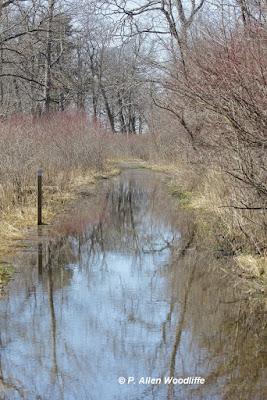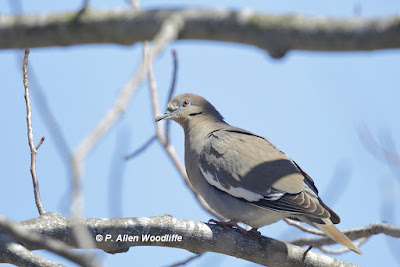I've had to pick and choose days and times to get out, since there have been a lot of other things going on. But a few trips have been made here and there to see what is around. Clearly the bird migration is way behind.....I've only seen one species of warbler so far! There should be at least half a dozen or more around, and from reading other's eBird posts, there is a handful of species that have shown up, but everyone is struggling to find more than one or two warblers (if any!) and other spring migrants that we normally expect.
A couple of trips to Rondeau these past few days didn't turn up anything all that unusual. But it was nice to see lots of the expected species. With a bit of effort, it wasn't hard to find 50-60 species in an outing.
Brown Creepers have been fairly abundant. It is a species that normally breeds well north of this area, although there has been at least a couple of breeding records in the park.
Both kinglets are common right now, but are constantly on the move. This Golden-crown was motionless for the same 1/640 second as my camera shutter for a change.
Northern Flickers are abundant. Normally they are a little shy for the camera, but since these two were more intent on asserting themselves to establish dominance, they let me get closer than usual.
With the lack of greenery in the forest so far, colourful birds such as Blue Jays show up rather well...
...as do Northern Cardinals.
This one decided to investigate what it considered a potential intruder in its territory, whereas in reality, it was seeing its own reflection in the truck mirror. Cardinals and robins are notorious for 'attacking' reflections of themselves sometimes for hours (and even days!) on end.
I got only my second Mourning Cloak of the season a couple of days ago...
...and my first of the season Red Admiral.
The White-winged Dove continues in some of its usual spots.
While walking through the campground, I noted several birds around a puddle in the grass. Some of them were American Robins, but I had my eye on one less commonly seen species. Can you see it in this next photo?
It is an American Woodcock, which relies heavily on camouflage and being completely still so as not to be seen. This one hunkered down in the dead oak leaves and hoped I wouldn't see it. It let me get less than a metre away from a different angle and didn't blink an eye.
Later in the afternoon yesterday I decided to check a flooded field near the corner of Bloomfield Road and Hwy 401, where I had seen hundreds of gulls and a few ducks and shorebirds a few days ago.
I had my first of year Greater and Lesser Yellowlegs on that occasion.
 |
| Greater Yellowlegs |
 |
| Lesser Yellowlegs |
When I got there I was told by the single birder there, that the godwit had left just a few minutes before, but the Willets were still along the lake shore. It was a treat to see them splashing and preening in the water, sometimes getting up and going for a short flight. A few other birders came and went while I was there.
There were Common Loons, a Black-bellied Plover and a Dunlin also around, among other species, and a bit later a flock of about 25 more Dunlin went flying by.
At first there was 'only' group of about 32 or 33 Willets. I got a few photos in the dim light. It was beginning to drizzle and a thunderstorm was brewing in the distance.
A little later another group of about 25 joined the first group.
This next photo shows the entire group of 57 or 58 birds in a relatively tight group. (Update: in getting a closer look at the group on the computer screen, the enlarged view shows that there are more than 58 birds. Some are clearly overlapping, so it is hard to separate some of them, but a couple of us have examined it more closely and have come up with 59 or 60.)
Today we went up to the Angler Line/Mitchell's Bay area. I was hoping to add a few species to my year list, including Yellow-headed Blackbird. I thought I heard one well out in the marsh, but with the wind it was not clear so did not count it. I did see at least 18 Great Egrets and 14 Black-crowned Night-Herons all out over the bay and Ticky Tacky Point off the end of Angler Line. No photos were obtained given the distance, so the photo of the Great Egret on the header will have to suffice.
A little later we came across one of the lingering Snowy Owls in a field just west of Winter Line, a bit south of Angler Line. It was feeding on something as it had its head down plucking away at its prey. Every so often a few white feathers would go floating off in the brisk northerly wind.
In the field across from St. Clair NWA was a single Sandhill Crane feeding in last year's corn stubble, while a couple of Bald Eagles were at the nest in the line of trees on the far side of the field.
A nicely marked male Ring-necked Pheasant was skulking along the roadside as I passed by the entrance to SCNWA. They used to be quite common in Chatham-Kent and Essex, but are now a rarity. This was my first of the year.
























































